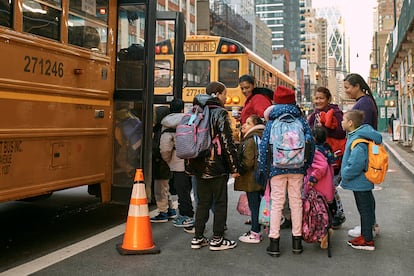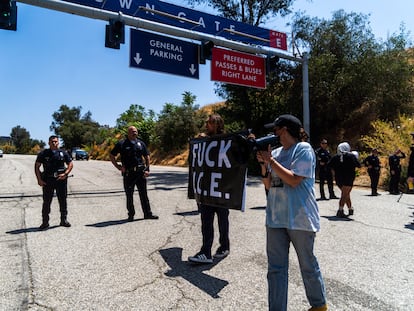End of the school year overshadowed by fear of immigration raids
Parents and teachers have raised concerns about immigration agents spotted around New York schools


There is less than one week left in the school year, but the teachers at Sunset Park are not letting their guard down. In this neighborhood located in western Brooklyn — known for its cultural richness and diversity, where about half the residents are immigrants — three elementary school teachers from a local school are patrolling the streets this Thursday in search of immigration agents. They are taking advantage of the holiday to spend the afternoon monitoring the area, after learning that immigration police had been making arrests just a few blocks from their school.
“They’ve been seen on these streets, in white and gray vans, or in black SUVs that have license plates but aren’t registered as federal vehicles,” says María, one of the teachers, who prefers not to give her last name or the name of the school where she works to protect her students. She’s referring to the streets surrounding the neighborhood’s central park, which stretches from Fifth Avenue to Seventh, west to east, and from 41st to 44th Street, north to south. “They’re seen mostly on weekends, but I’ve seen them during the week too, wandering around at 4:00 p.m., when the kids get out of school. They also hang around near subway stops.”
According to María, and other reports on social media, Immigration and Customs Enforcement (ICE) activity in Sunset Park has been concentrated along Fifth Avenue, the neighborhood’s main thoroughfare, filled with Latino restaurants, fruit markets, and other businesses. Just one block west, on Fourth Avenue, there are more than 10 schools — including María’s. The proximity of ICE agents to so many schools has put the community on edge: it fears that arrests might happen at the schools at any moment.
So far, that hasn’t happened. There hasn’t been a single instance of immigration agents entering a school to detain a student, either in New York or in the rest of the country, since Donald Trump returned to power last January. In California, they attempted to enter two Los Angeles elementary schools in April but were denied entry. As the school year draws to a close, immigration agents have been seen loitering near graduations and other end-of-year activities.
Fear of arrests taking place inside schools has rapidly intensified since Trump revoked the directive designating certain locations — schools, hospitals, and churches — as “sensitive areas,” where raids were not allowed. The Republican president later also authorized arrests in immigration courts to increase detention numbers, setting a daily quota of 3,000 arrests. In the past month, hundreds of people have been detained during their court appointments across the country.
“The fear really escalated when they started raiding the local courts. Both parents and school staff are on high alert,” says María. The kindergarten teacher worries about her students and their families: of her 15 students, 11 are immigrants. She knows that some of them are undocumented or come from families with mixed immigration status because the parents have told her. In general, it is difficult to determine how many students in New York are undocumented, since public schools do not record the immigration status of their students. But it is known that since the summer of 2022, more than 40,000 immigrant students have enrolled in the city’s public schools as a result of the recent mass influx of immigrants to the Big Apple.
The Trump administration’s anti-immigrant offensive has had serious consequences for immigrant students and their families. María recalls that in the first weeks of the Republican administration, absences skyrocketed: “Children stopped coming to school or were late for fear of leaving their homes.” A new study by Stanford University puts numbers to the absenteeism that many teachers like María observed between January and February: the research found that immigration raids during those months increased the number of daily absences by 22%.
The study’s author, Professor Thomas Dee, focused on schools in California’s Central Valley, a major agricultural region with a large immigrant population. The researcher analyzed the southern part of the region, where 70% of the more than half a million students are Hispanic. He selected five schools in the area and examined three years of attendance data. He found that absences increased between January and February following a series of immigration raids that began in the area in the final days of the Biden administration, but which were perceived as a sign of what was to come under Trump.
Dee notes that the rise in absences threatens these students’ learning and academic performance, as well as their mental health. His findings, he argues, can be seen as a “leading indicator of broad and developmentally harmful stress these raids create for students and their parents.”
School ICE drills
Aware of the fear among students and faculty, the school where María works established an emergency protocol in February in case immigration authorities arrive at the school. It’s a closed-door policy: no federal immigration agent will be allowed entry to the school without a warrant signed by a judge. If they do present a warrant, it will be reviewed by the school administration, and they will be allowed access only to the lobby.
Since the protocol was implemented, the school has also conducted drills to ensure that both teachers and students know how to act if immigration authorities show up at the school. “Just as we conduct drills for other emergencies, such as if there were a shooter in or near the school, we also conduct drills for if ICE arrives. We’ve conducted two: one just for teachers and one for students,” María says.
María’s school also has a strict policy for parents and family members picking up students. They must be registered with the school or provide some kind of PIN number before being allowed to pick up the child.
New York has pledged to protect its immigrant students in the face of the Trump administration’s policies. When ICE detained a Venezuelan high school student seeking asylum in May as he left an immigration court hearing, the city’s schools chancellor, Melissa Avilés-Ramos, insisted that New York City schools remained safe havens for immigrants. “We will continue to speak out and advocate for the safety, dignity, and rights of all of our students,” she said.
Sign up for our weekly newsletter to get more English-language news coverage from EL PAÍS USA Edition
Tu suscripción se está usando en otro dispositivo
¿Quieres añadir otro usuario a tu suscripción?
Si continúas leyendo en este dispositivo, no se podrá leer en el otro.
FlechaTu suscripción se está usando en otro dispositivo y solo puedes acceder a EL PAÍS desde un dispositivo a la vez.
Si quieres compartir tu cuenta, cambia tu suscripción a la modalidad Premium, así podrás añadir otro usuario. Cada uno accederá con su propia cuenta de email, lo que os permitirá personalizar vuestra experiencia en EL PAÍS.
¿Tienes una suscripción de empresa? Accede aquí para contratar más cuentas.
En el caso de no saber quién está usando tu cuenta, te recomendamos cambiar tu contraseña aquí.
Si decides continuar compartiendo tu cuenta, este mensaje se mostrará en tu dispositivo y en el de la otra persona que está usando tu cuenta de forma indefinida, afectando a tu experiencia de lectura. Puedes consultar aquí los términos y condiciones de la suscripción digital.
More information
Archived In
Últimas noticias
Welcome to the post-religion era: The idea of Christianity as the absolute truth has become obsolete
‘I thought you would like it’: The risky sexual practice popularized by TV shows and TikTok
The digitalization of tourism: ‘They promise experiences and gave us the worst possible one’
Mexican peso defies uncertainty with forecasts of a new period of stability in 2026
Most viewed
- Sinaloa Cartel war is taking its toll on Los Chapitos
- Oona Chaplin: ‘I told James Cameron that I was living in a treehouse and starting a permaculture project with a friend’
- Reinhard Genzel, Nobel laureate in physics: ‘One-minute videos will never give you the truth’
- Why the price of coffee has skyrocketed: from Brazilian plantations to specialty coffee houses
- Silver prices are going crazy: This is what’s fueling the rally










































